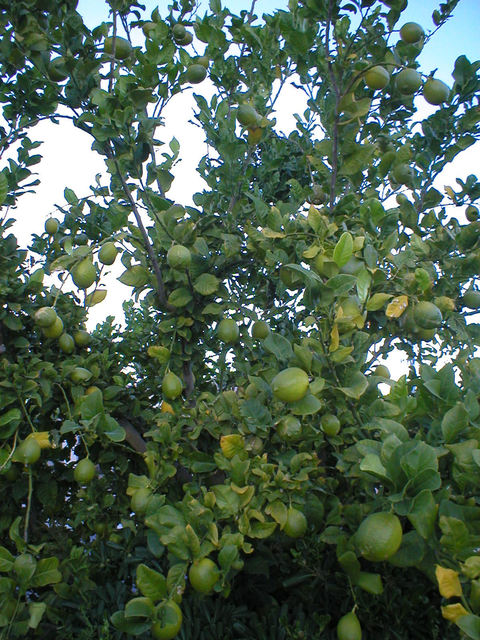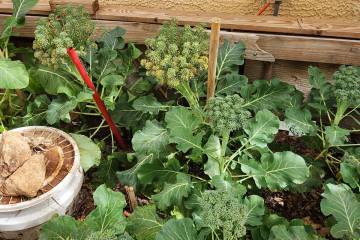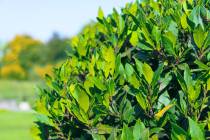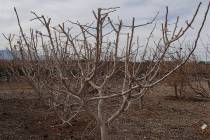Some plants need protection from freezing temperatures
Q: It got to 30 degrees overnight in Boulder City. I’m worried about my little 6-foot lemon tree in a 5-gallon pot on the porch. I placed a queen-size bed sheet over the tree and hung a 100-watt incandescent lamp from a branch last night. I’m hoping that small amount of heat will raise the temperatures above freezing. Is this necessary?
A: Freezing temperatures have two components: the low temperature you reported of 30 degrees Fahrenheit and its duration — or how long that freezing temperature lasts. The longer damaging temperature lasts the more damage it does. Meyer lemon tolerates freezing temperatures than other lemons.
To answer your question, yes, a light bulb can help. Keep the bulb from burning leaves and stems. Ultimately, its success depends on how windy it was, the freeze’s duration and the type of cover used. It is best if the cover reaches the ground so that large, warm surfaces can radiate heat back to the tree.
Hanging a light bulb that gives off heat helps a tree if there is no wind or the wind is blocked. If wind is present, heat from the bulb is questionable. Covering a tree with a sheet or burlap helps keep the wind off the tree and traps warm air under it for a short time.
Open flowers, young fruit and new growth are the most sensitive parts of any fruit tree. Open flowers of any fruit tree, whether the fruit tree can withstand -20 F or 32 degrees Fahrenheit, will always be damaged, if not outright killed, when temperatures hit 32 degrees Fahrenheit for the shortest period of time.
If flowers were open and the temperatures hit 31 degrees Fahrenheit for 30 minutes, the flowers, and any possible fruit it would produce, are dead and gone.
Unopened flowers and young fruit are slightly more tolerant of freezing temperatures. If temperatures dropped to 28 degrees Fahrenheit for 30 minutes, very young fruit will be killed and drop from the tree.
Larger fruit is damaged at lower temperatures. The extent of damage depends on the “antifreeze” (sugar content) of the fruit. New, tender growth is damaged just below freezing, too.
Established trees are different. Each type of citrus has its own tolerance to freezing, but all citrus is considered tender to freezing temperatures. This is why growing citrus in the Las Vegas area is considered risky.
Young citrus trees are damaged more than mature citrus at the same temperatures and durations. Mature citrus recovers from freezing temperatures that might kill a young citrus of the same kind.
Q: I am a first-time tree rose grower living in Pahrump. They did great this past summer. How can I protect them from winter damage?
A: The problems with tree roses are making it through our cold winters (they are more tender compared to bush type roses) and root rot because of poor soil drainage. I have not encountered it, but I am guessing sunscald (sun damage due to our high light intensity) on the trunk or stems during summer months might also be a problem.
Tree roses are grafted in two locations: just above the soil and another on top of the long cane or stem that supports the roses.
Pahrump is colder than the Las Vegas Valley. Protecting tree roses from low winter temperatures will be a must. Both of these graft unions should be protected. Protecting the bottom graft union, just above soil level, is not difficult. Pile mulch or wrap the base of the plant with an insulated, protective covering.
The second graft union is on top of the single cane, just below the roses. This graft union might be 3 or 4 feet above the soil level. Protecting this graft union is more difficult. I suppose the simplest way is to take some insulation and wrap the graft union at this height and secure it to the cane.
Make sure the soil used for planting drains freely. Roots of these plants won’t tolerate poor drainage or standing water. When planting tree roses, make sure the hole is at least three times the diameter of the container. The hole does not have to be deep if it drains.
Amend the soil used for planting with compost in a 50-50 mix or use a good-quality planting soil mix. Tree roses should be staked to keep them upright. Stake them at the time of planting. They perform better with a 3- to 4-inch layer of woodchip mulch covering the soil, but keep the mulch 12 inches away from the trunk.
To help prevent sunscald, put the stake on the southwest side of the cane and secure it. Grow tall plants around tree roses on the south and west sides. This helps shade the cane and prevent sunburn, too.
Be careful of using tree wraps in intense sunlight. Some intensify the heat problem on the trunk. If you use one, make sure it is light-colored and can breathe.
Planting location can be important. Plant them on the east side of a building or wall where they can avoid afternoon sun. Put them in areas of the yard where they are out of strong winter winds and reflected sunlight during the summer.
Another option is to plant them in containers and move them into protected areas after leaf drop but before damaging winter temperatures.
Q: Attached is a photo of my 12-year-old apricot tree. I have never seen these gummy pustulelike objects on the tree before this month. They cover nearly the entire tree. Can you tell me what this is and whether it needs treating?
A: When we see bubbles of sap coming from the trunk and limbs, and it is sudden, it is because of stress. Many people assume that sap coming from a tree always means it has borers. This is not true.
Sap coming from trees caused by boring insects, or borers, does not cover the entire tree and it does not come quickly. Damage from borers is gradual, sometimes taking its toll in two, three or even four years.
Damage from borers usually affects one limb at a time and gradually progresses to other limbs. Damage from boring insects is more intense on the hottest side of the tree: south and west sides.
I wish I could diagnose it as more than just stress, but I can’t without learning more about the tree’s history and its management. You had this tree for 12 years, and it sounds as if it has been healthy during those 12 years.
Therefore, I rule out normal management practices (irrigation, fertilizers, pest control) that have been done the same way year after year. I’ll go out on a limb and make some guesses, though.
I am guessing this stress was caused by either an improper fertilizer application, such as putting too much fertilizer close to the trunk, spraying a liquid fertilizer from a dirty or unwashed applicator, or a pesticide application to the tree or near the tree. I am leaning toward a pesticide application.
Make sure applications of pesticides or liquid fertilizers were made with clean equipment. If equipment used for spraying the tree contained weed killers or other contaminants prior to the application, it can cause tree stress and damage.
Think about weed killer applications made to the ground near or nearby the tree. Some weed killers contain chemicals that can damage the tree even if it is applied to weeds or the soil.
Think about weed killer applications made by neighbors on a windy day. These sprays can drift with the wind and cause stress.
Whatever the cause, all you can do is wait and see what happens. There is no chemical or management that you can do to help the tree at this point. Keep managing the tree as you would do normally and hopefully the tree will recover.
Bob Morris is a horticulture expert living in Las Vegas and professor emeritus for the University of Nevada. Visit his blog at xtremehorticulture.blogspot.com. Send questions to Extremehort@aol.com.




























